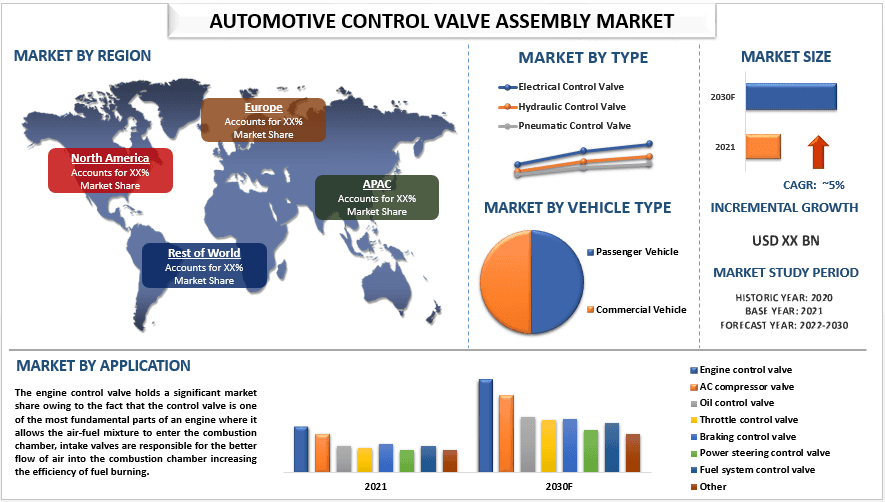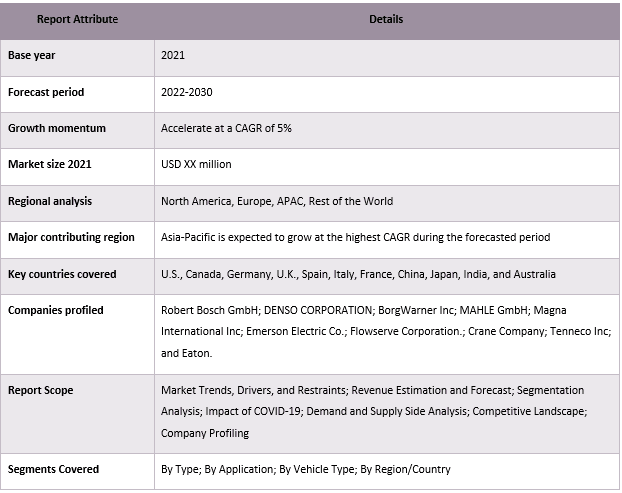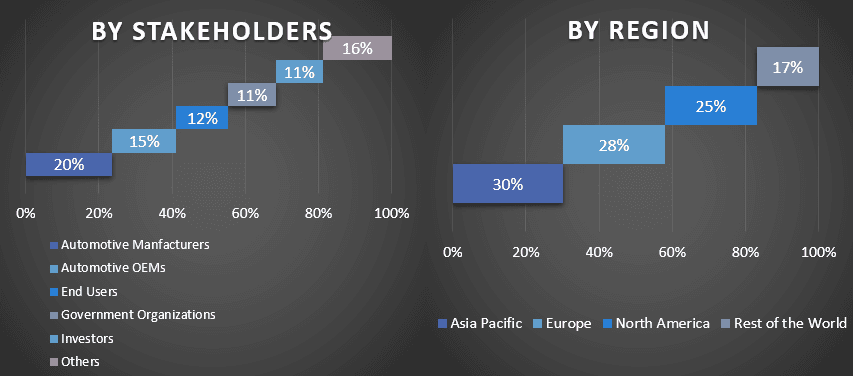Automotive Control Valve Assembly Market: Current Analysis and Forecast (2022-2030)
Emphasis on Type (Electrical Control Valve, Hydraulic Control Valve, and Pneumatic Control Valve), Application (Engine Control Valve, AC Compressor Valve, Oil Control Valve, Throttle Control Valve, Braking Control Valve, Power Steering Control Valve, Fuel System Control Valve, and Others), Vehicle Type (Passenger Vehicle and Commercial Vehicle), and Region/Country.

The automotive control valve assembly market is expected to grow at a steady CAGR of around 5% during the forecast period.
Automobile control valve assembly is used for controlling the flow of fluid by changing the size of the passage of flow according to the controller and enables direct control over the flow rate. Control valves are used for a very wide array of applications in the automobile industry such as on-off application, throttling, pressure, and flow control. Moreover, for efficient fuel combustion electronic valves are used which ensures precise air mass supply, becoming an integral part of an engine. Furthermore, this era of electrification of vehicles where the whole automobile industry is going through a dynamic shift is also generating a huge demand for control valves which are essential for the thermal management of EV batteries where control valves ensure efficient cooling fluid management, thus making EV safer and reliable to operate which further contributes in EV adoption which is increasing at an impressive rate. For instance, on July 2022, the Indian Minister of State for Heavy Industries shared data according to which, the number of electric vehicles (EVs) currently on road has seen a significant rise since 2020. A total of 1,19,000 units of EVs were sold in 2020, which increased to 3,11,000 units in 2021 and 4,19,000 units in 2022.
Some of the major players operating in the market include Robert Bosch GmbH; DENSO CORPORATION; BorgWarner Inc; MAHLE GmbH; Magna International Inc; Emerson Electric Co.; Flowserve Corporation.; Crane Company; Tenneco Inc; and Eaton.
Insights Presented in the Report
Based on type, the market is segmented into electrical control valve, hydraulic control valve, and pneumatic control valve. Among these, the electrical control valve is going to grow at a significant CAGR during the forecasted period. Owing to the fact that they are electro-mechanical control valves that offers highly accurate control positioning, offers flexible motion control, low operating cost, compact in design, and easy maintenance as it does not use oil for their operation. Moreover, the electronic throttle valve offers the most efficient fuel combustion in the engine. Furthermore, they are used extensively in several automotive applications such as fuel injection systems, transmission control systems, and turbocharger control systems, because of their precision, reliability, and efficiency.
“Asia Pacific dominated the automotive control valve assembly market in 2021.”
The automotive control valve assembly market in the Asia Pacific region held the largest market share and is expected to maintain its growth throughout the forecast period. Major countries in the Asia Pacific like India, China, Vietnam, etc are going to be the biggest market for the automotive control valve assembly market owing to the increasing economic growth rate in these countries which are some of the fastest growing economies in the world, driving the consumption with increasing income, and automobile sectors have been proven to be the biggest beneficiaries of these trends as it has happened in past in the developed world. Moreover, China is still the world’s biggest automobile market followed by India and other Asia Pacific countries owing to its huge population and increased mobility with the working population on the rise thus generating a huge demand for automotive valve assembly. Furthermore, increased government spending on developing new infrastructure has increased the rate of urbanization which is also becoming a major driver for the demand in the automobile sector. For instance, on February 2023, the Indian government presented a budget where they announced a whopping 37.4% increase in capital expenditure on infrastructure to USD 125 billion for the year 2023-24.
Automotive Control Valve Assembly Market Report Coverage

Reasons to buy this report:
- The study includes market sizing and forecasting analysis validated by authenticated key industry experts.
- The report presents a quick review of overall industry performance at one glance.
- The report covers an in-depth analysis of prominent industry peers with a primary focus on key business financials, product portfolios, expansion strategies, and recent developments.
- Detailed examination of drivers, restraints, key trends, and opportunities prevailing in the industry.
- The study comprehensively covers the market across different segments.
- Deep dive regional level analysis of the industry.
Customization Options:
The global automotive control valve assembly market can further be customized as per the requirement or any other market segment. Besides this, UMI understands that you may have your own business needs, hence feel free to connect with us to get a report that completely suits your requirements.
Table of Contents
Research Methodology for the Automotive Control Valve Assembly Market Analysis (2022-2030)
Analyzing the historical market, estimating the current market, and forecasting the future market of the global automotive control valve assembly market were the three major steps undertaken to create and analyze the adoption of automotive control valve assembly in major regions globally. Exhaustive secondary research was conducted to collect the historical market numbers and estimate the current market size. Secondly, to validate these insights, numerous findings and assumptions were taken into consideration. Moreover, exhaustive primary interviews were also conducted, with industry experts across the value chain of the global automotive control valve assembly market. Post assumption and validation of market numbers through primary interviews, we employed a top-down/bottom-up approach to forecasting the complete market size. Thereafter, market breakdown and data triangulation methods were adopted to estimate and analyze the market size of segments and sub-segments of the industry pertains to. Detailed methodology is explained below:
Analysis of Historical Market Size
Step 1: In-Depth Study of Secondary Sources:
Detail secondary study was conducted to obtain the historical market size of the automotive control valve assembly market through company internal sources such as annual reports & financial statements, performance presentations, press releases, etc., and external sources including journals, news & articles, government publications, competitor publications, sector reports, third-party database, and other credible publications.
Step 2: Market Segmentation:
After obtaining the historical market size of the automotive control valve assembly market, we conducted a detailed secondary analysis to gather historical market insights and share for different segments & sub-segments for major regions. Major segments are included in the report as type, application, and vehicle type. Further country-level analyses were conducted to evaluate the overall adoption of testing models in that region.
Step 3: Factor Analysis:
After acquiring the historical market size of different segments and sub-segments, we conducted a detailed factor analysis to estimate the current market size of the automotive control valve assembly market. Further, we conducted factor analysis using dependent and independent variables such as type, application, and vehicle type of the automotive control valve assembly market. A thorough analysis was conducted for demand and supply-side scenarios considering top partnerships, mergers and acquisitions, business expansion, and product launches in the automotive control valve assembly market sector across the globe.
Current Market Size Estimate & Forecast
Current Market Sizing: Based on actionable insights from the above 3 steps, we arrived at the current market size, key players in the global automotive control valve assembly market, and market shares of the segments. All the required percentage shares split and market breakdowns were determined using the above-mentioned secondary approach and were verified through primary interviews.
Estimation & Forecasting: For market estimation and forecast, weights were assigned to different factors including drivers & trends, restraints, and opportunities available for the stakeholders. After analyzing these factors, relevant forecasting techniques i.e., the top-down/bottom-up approach were applied to arrive at the market forecast for 2030 for different segments and sub-segments across the major markets globally. The research methodology adopted to estimate the market size encompasses:
- The industry’s market size, in terms of revenue (USD) and the adoption rate of the automotive control valve assembly market across the major markets domestically
- All percentage shares, splits, and breakdowns of market segments and sub-segments
- Key players in the global automotive control valve assembly market in terms of products offered. Also, the growth strategies adopted by these players to compete in the fast-growing market
Market Size and Share Validation
Primary Research: In-depth interviews were conducted with the Key Opinion Leaders (KOLs) including Top Level Executives (CXO/VPs, Sales Head, Marketing Head, Operational Head, Regional Head, Country Head, etc.) across major regions. Primary research findings were then summarized, and statistical analysis was performed to prove the stated hypothesis. Inputs from primary research were consolidated with secondary findings, hence turning information into actionable insights.
Split of Primary Participants in Different Regions

Market Engineering
The data triangulation technique was employed to complete the overall market estimation and to arrive at precise statistical numbers for each segment and sub-segment of the global automotive control valve assembly market. data was split into several segments & sub-segments post studying various parameters and trends in the areas of type, application, and vehicle type in the global automotive control valve assembly market.
The main objective of the Global Automotive Control Valve Assembly Market Study
The current & future market trends of the global automotive control valve assembly market were pinpointed in the study. Investors can gain strategic insights to base their discretion for investments on the qualitative and quantitative analysis performed in the study. Current and future market trends determined the overall attractiveness of the market at a regional level, providing a platform for the industrial participant to exploit the untapped market to benefit from a first-mover advantage. Other quantitative goals of the studies include:
- Analyze the current and forecast market size of the automotive control valve assembly market in terms of value (USD). Also, analyze the current and forecast market size of different segments and sub-segments
- Segments in the study include areas of type, application, and vehicle type.
- Define and analysis of the regulatory framework for the automotive control valve assembly industry
- Analyze the value chain involved with the presence of various intermediaries, along with analyzing customer and competitor behaviors of the industry
- Analyze the current and forecast market size of the automotive control valve assembly market for the major region
- Major countries of regions studied in the report include Asia Pacific, Europe, North America, and the Rest of the World
- Company profiles of the automotive control valve assembly market and the growth strategies adopted by the market players to sustain in the fast-growing market
- Deep dive regional level analysis of the industry
Related Reports
Customers who bought this item also bought










